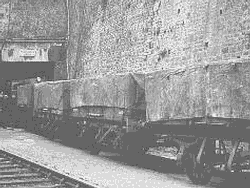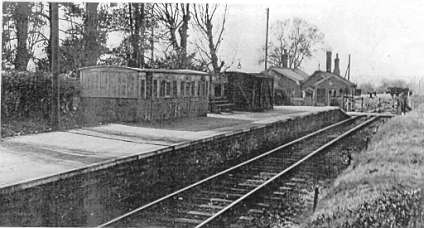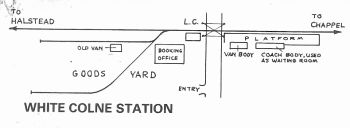Ammunition destined for
the Bures storage area was transported by train to Earls Colne &
White Colne railway stations. These were located on the Colne Valley
line which traversed the countryside from Haverhill to Chapel &
Wakes Colne Stn, where it linked up with the Stour Valley line.
By May 1943, Earls Colne
station & White Colne had become the bomb and ammunition supply
depots for some 30 airfields in Essex and Suffolk.
The obvious question seems
to be, "Why didn`t they off-load the ammunition trains at Bures?".
There could have been more than one reason such as
(a) The risk was too high with the bomb storage site within such close
proximity. It was essential to keep the Luftwaffe away from Bures and
not attract to much attention.
(b) The station was to close to the village centre.
(c) Lack of suitable sidings.
To make use of all the available space, the road between White Colne
and Bures was also used for bomb storage.
The road was widened by the USAAF in order to facilitate the large amount
of truck movements and to provide road side storage bays.
Dumps were also positioned at the top of Boley Road, up to Catleys Farm
and around Countess Cross.
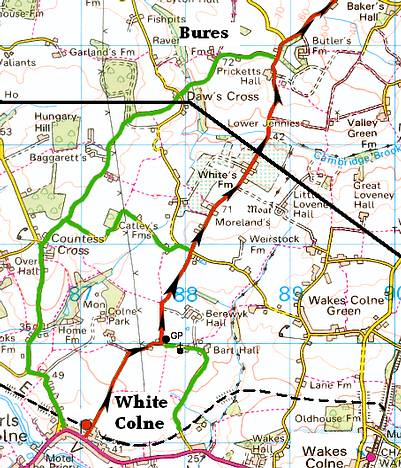 |
Along the White
Colne to Bures road there was a Guard Post located on the corner,marked
with GP
The american guards used the local church tower (to the right)
as target practice, trying to hit the weather vane.
There was also
a Nissen hut just to the North of White Colne station (now Hill
Farm). This was not a Guard Post but was used by USAAF Officers,
presumably for admin purposes.
Key:-
Main delivery route to Bures indicated red with arrows. The return
journey to the A604 from Bures seems to have been via Daws Cross,
Countess Cross and White Colne to the main road.
Bombs were stored
along both routes.
Other supply and dispersal roads within White & Wakes Colne
coloured `green`
Colne Valley railway shown as black dotted line.
Earls Colne Station to the left.
|
To give some idea of the size
of these trains arriving in the area, this text describes a typical
ammunition train formation arriving from Grimsby.
On 31st May 1944 a consignment
of bombs and components for the United States Air Force was taken off
ship and on to sixty-one railway wagons at Immingham on the Humber,
destined for White Colne in Essex. This long train left Immingham Sidings
at 2. 55am. On 1st June 1944, travelling so slowly that it took seven
hours to cover the eighty-nine miles to March in Cambridgeshire.
It arrived at March Yard, which was subsidiary to the nearby marshaling
yard at Whitemoor (where today stands the high security prison), where
the wagons were, as always, carefully inspected. The ten leading wagons
were then detached to be worked forward by convenient services later,
leaving the fifty-one wagons and the guard's van in Number One Siding
Coal Yard. These remained in the yard for fourteen-and-a-half hours
unaltered in formation until they left at 12.15am. On Friday 2nd June
1944 as the delayed 11.40pm (1st June 1944) train from Whitemoor to
White Colne.
Forty-four of those wagons were laden with 250-pound and 500-pound bombs,
un-fused, amounting to approximately four hundred tons in all and another
six with detonators and primers, fuses, wire release gear and bomb tail
fins, all firmly stacked under tarpaulin sheets of low combustibility
with the care that had prevented any major crisis in the transportation
of weaponry on British railways throughout the war, one wagon remained
empty.
(Acknowledgment to www.soham.org.uk)
Powerful main line (Gresley 2-8-0)trains,
could pull 60-70 trucks weighing in at some 1000 tons. These would normally
arrive from Liverpool at Whitemoor marshalling yard near March in Cambridgeshire.
Here they were then reduced in length too no more that 50 trucks. This
enabled the train to shunt into passing sidings on the more local lines,
enabling faster passenger trains to pass.
Ammunition trains were classed as "Specials" and had no priority
over the normal day to day traffice.
The top speed would have only been in the region of 30mph and so it
took a full 8 hour shift to convey the train from Whitemoor to Chappel
or Marks Tey.
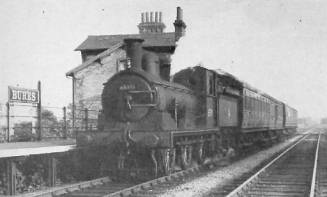 |
On arrival they were split yet
again in order for the smaller branch line (J15`s)locomotives
to take them along the Colne Valley line. The line could only
take about 20 trucks due to the limitations of the track bed and
bridges.
The trucks were placed into sidings at Chappel and Marks Tey,
ready for onward transmission to either Earls or White Colne.
|
The main line Gresley would turn around
at Marks Tey ready for its empty journey back to Whitemoor, Marks Tey
was the only station capable of turning around this size of locomotive.
Harry Gilbert (dec) Station Master at
Earls Colne recalls one morning thirty to forty trucks waiting to be
loaded, the queue stretched right up to the Earls Colne High St. The
main task of unloading and loading the ammunition fell to the black
servicemen, who were despised by their white comrades.
|
|
Photo of ammunition train.
Photographs of war time trains
are extremely rare, it was not advisable during the offensive
to be seen wandering around with a camera.
The picture above is the only reference
so far found.
|
Normally, the main line locomotives were
dealt with at Marks Tey yard, as it was the only place the main line
train could run/turnaround and return back up the Stour Valley line.
It was not unusual to find Chappel and Marks Tey yards choked to capacity
with bombs. On rare occasions when both yards were full to overflowing,
Colchester had to be used, although this was frowned upon, owing to
the possible danger to the town.
Also, when Earls Colne,White Colne and other yards were full to capacity,
other dropping off points were used such as:-
Halstead
Hedingham
Felstead
Stansted
Bishops Stortford
Clare
Rayne
Munitions were then transported to the airfields direct and the surplus
to the Bures dispersal site.
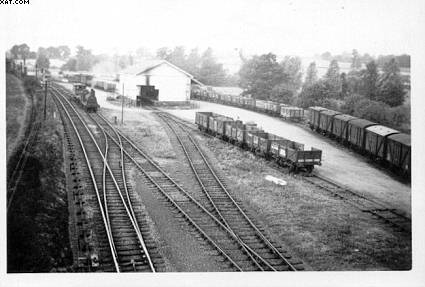 |
Earls Colne Sidings, circa 1945
It was the
length of the yard and the loop at Earls Colne that limited train
length on the branch line. Those wagons which were dropped off
at White Colne had to go to Earls Colne first to run round as
White Colne could only be easily accessed from a train in the
Chappel bound direction, as it had no loop just a trailing siding.(see
map below)
|
Chappel
> Earls Colne direction
The yard at Earls Colne could take up
to 50 trucks, but remember this included the White Colne portion which
had to be turned around. Consequently the train was shunted into the
yard, the Earls Colne section uncoupled and the White Colne wagons pushed
back into the main line, ready to return towards Chappel.
Usually the train (0-6-0, J15`s) were
restricted to about 18 - 20 trucks, approx 300/400 tons.
This invariably meant three local trips
per main line delivery.
Records indicate the number of wagons delivered during the three Summer
months of 1944 as:
White Colne 2971
Earls Colne 3959
This equates to 38 wagons a day at White Colne & 51 a day at Earls
Colne (based on a six day week, 13 week period). That suggests three
or four trains a day to Earls Colne (Run round and drop off/pick
up just over half) and White Colne (drop off/pick up rest).
In the second quarter of 1943 the two
stations handled something like 100,000 tons of bombs.
On occasions a larger `WD` engine complete with servicemen crew would
take 24 -26 trucks along the line. Instructions were then issued, to
leave this train on the main loop, until a smaller engine shunted the
trucks into the yard. It was hazardous to allow this larger locomotive
to enter the yard due to the tight curves and terrible state of the
track.
There is one incident mentioned, where
the `WD` loco was allowed into the White Colne yard and subsequently
derailed. With the help of the USAAF servicemen, muscle and manpower
the loco was eventually slewed back onto the track. No report was ever
made of this incident, but it did highlight the need to keep heavy and
long wheel base loco`s out of the sidings.
Haverhill
> Halstead > Earls Colne direction
Although the larger `WD` loco`s worked
the Chappel section they were not allowed beyond Earls Colne towards
Halstead
Only J15, 0-6-0`s were allowed the Halstead side because of a weight
restriction on a wooden trestle bridge.
Ammunition trains occasionally came in from the Haverhill/Halstead direction
but their load was limited because of this crossing.
Although White Colne was extremely
busy, it didn't boast much creature comfort. From the photograph above,
the waiting room consisted of a dilapidated coach body. The Booking Hall
today now functions as the Village hall. The sidings would have been behind
the level crossing.
The bombs were offloaded in the sidings
and packed into USAAF trucks, the rear being packed with straw to stabilise
the load.
Gilbert Brackley from White Colne recalls one incident, where the straw
caught fire on one of the lorries. With a lot of shouting and gesticulating,
the truck was stopped and the bombs hastily offloaded with a reasonable
degree of panic !
Arriving at the storage site, the bombs
were offloaded with the aid of a tracked crawler (caterpillar tractor)
with an attached crane on the front.
With no detonators installed, safety didn`t seem to be to much of an
issue.
There doesn`t appear to be any record of any accidental explosions along
the roadsides.
OPERATION
OVERLORD - D- DAY 6th June 1944
Train Movements 6th June 1944
| FROM |
TO |
Alternative
Destination |
Wagon
No`s |
Arrived |
| 1400
Immingham |
White
Colne |
Marks
Tey |
39 |
Marks
Tey 0845 6/6/44 |
| 1500
Immingham |
White
Colne |
Marks
Tey |
59 |
Marks
Tey 1030 6/6/44 |
| 1600
Immingham |
White
Colne |
Stansted |
60 |
Stansted
7/6/44 |
| 1855
Immingham |
White
Colne |
Rayne |
60 |
|
| 1400
Tyne Dock |
White
Colne |
|
60 |
|
| 1500
Middlesburgh |
White
Colne |
Stansted |
57 |
7/6/44 |
| 1600
Middlesburgh |
White
Colne |
Halstead |
47 |
7/6/44 |
| 0829
Immingham |
White
Colne |
Felstead |
59 |
Felstead
1540 6/6/44 |
| 0800
Middlesburgh |
White
Colne |
White
Colne |
50 |
7/6/44 |
| 0400
Middlesburgh |
White
Colne |
Hedingham |
49 |
7/6/44 |
| 0407
Immingham |
White
Colne |
|
23 |
|
| 0300
Tyne Dock |
White
Colne |
|
48 |
|
| 2130
Middlesburgh |
White
Colne |
|
46 |
8/6/44 |
Wagon
Movements 6th June - Sept 1944
| White Colne
|
2971 |
| Earls Colne |
3959 |
| Halstead |
288 |
| Felstead |
48 |
| Stansted |
405 |
| B. Stortford
|
129 |
| Clare |
243 |
| Rayne |
22 |
Even after the war ended,
bombs were still in place some three years later. According to an
ex-signalman from White Colne station they were loaded back into wagons
and transported to docks such as Harwich.
Another ex-serviceman
also told me how they were loaded onto lorrries and taken over to
Ridgewell Airfield for temporary storage. Later they were taken to
Gt Yeldham railway station for shipment to presumably to the docks.
Ridgewell was not finally cleared until early in the 1950`s
However, the general consensus is that all of the bombs were loaded
onto ships and finally dumped out to sea.
Acknowledgement to
Paul Lemon, researcher at Colne Valley Railway
Gilbert Brackley, White Colne
Victor Sayer, ex Earls Colne Signalman.
"By Rail to Victory" by Norman Crump
Colne Engaine History Society
Eric Gilbert, Bill
Lincoln.
![]()


